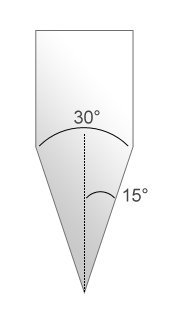Find the correct sharpening angle
Are you just getting started with sharpening with a whetstone, and do you need help finding the correct angle? We can help. First of all, consider which sharpening stone to start with. The right angle determines the sharpness of the knife.
Determine the sharpening angle for your knife
The cutting edge of a knife can have different angles. The smaller the angle, the sharper the knife. Therefore, the cutting edge of a very sharp knife, is very narrow. Japanese knives are made of very hard steel (starting from 60 HRC) and can be made extremely sharp, when sharpened under a small angle. Other, for example German knives (55-58 HRC), often are made of slightly softer types of steel and are sharpened under a wider angle.
The angle of the cutting edge of Japanese knives is usually 30°. For normal knives you can use an angle between 36° and 40°. The sharpening angle for your knife is half the angle of the cutting edge (after all, you will sharpen on 2 sides). The sharpening angle of a Japanese knife (please find a few examples below) is therefore 15° (30°/2) and of other knives 18° to 20°.
Does your knife become dull or does it damage quickly? Then maybe you are sharpening the knife too thin. In this case, we recommend using a larger sharpening angle.
 Very sharp
Very sharp
 Normal use
Normal use
Examples of brands that carry knives made of hard steel (sharpening at an angle of 15°) Böker, Eden, Kai, Miyabi by Zwilling, Robert Herder and Sakai Takayuki.
If it's still unclear, there's always the 'pen trick'.
How high do you keep the back of your blade when sharpening
The grinding angle which you will achieve, is determined by the height of the back of your knife against the stone. You can determine the correct height with a simple formula. If you have determined the required grinding angle, measure the width of the knife. Then look in the table below how high you must keep your knife against the stone.
| Width of the blade | Sharpening angle 12° | Sharpening angle 15° | Sharpening angle 18° | Sharpening angle 20° | Sharpening angle 23° |
|---|---|---|---|---|---|
| 10 mm | 2.08 mm | 2.59 mm | 3.09 mm | 3.42 mm | 3.91 mm |
| 15 mm | 3.12 mm | 3.88 mm | 4.64 mm | 5.13 mm | 5.86 mm |
| 20 mm | 416 mm | 5.18 mm | 6.18 mm | 6.84 mm | 7.82 mm |
| 25 mm | 5.20 mm | 6.47 mm | 7.73 mm | 8.55 mm | 9.77 mm |
| 30 mm | 6.24 mm | 7.77 mm | 9.27 mm | 10.26 mm | 11.72 mm |
| 35 mm | 7.28 mm | 9.06 mm | 10.82 mm | 11.97 mm | 13.68 mm |
| 40 mm | 8.32 mm | 10.35 mm | 12.36 mm | 13.68 mm | 15.63 mm |
| 45 mm | 9.36 mm | 11.65 mm | 13.91 mm | 15.39 mm | 17.58 mm |
| 50 mm | 10.40 mm | 12.94 mm | 15.45 mm | 17.10 mm | 19.54 mm |
| 55 mm | 11.44 mm | 14.24 mm | 17 mm | 18.81 mm | 21.49 mm |
| 60 mm | 12.47 mm | 15.53 mm | 18.54 mm | 20.52 mm | 23.44 mm |
Helpful tools to sharpen with the correct height
If you don't want to work with a ruler, there are two sharpening rail set helpers that we can recommend. The sharpening rail is clamped on the back of the knife. The small sharpening rail creates a fixed height of 4.5mm. The bigger sharpening rail creates a fixed height of 6.5mm. This means, that when using a sharpening rail your are less flexible with your angle than if you choose the angle manually. In this table below we show the possible heights:
| Height of the blade | Sharpening angle 12° | Sharpening angle 15° | Sharpening angle 18° | Sharpening angle 20° | Sharpening angle 23° |
|---|---|---|---|---|---|
| 10 mm | 2.08 mm | 2.59 mm | 3.09 mm | 3.42 mm | 3.91 mm |
| 15 mm | 3.12 mm | 3.88 mm | 4.64 mm | 5.13 mm | 5.86 mm |
| 20 mm | 4.16 mm | 5.18 mm | 6.18 mm | 6.84 mm | 7.82 mm |
| 25 mm | 5.20 mm | 6.47 mm | 7.73 mm | 8.55 mm | 9.77 mm |
| 30 mm | 6.24 mm | 7.77 mm | 9.27 mm | 10.26 mm | 11.72 mm |
If you use a sharpening rail, we recommend to apply a strip of adhesive tape on the back of the knife before clamping on the sharpening rail, to prevent damage of the blade.









